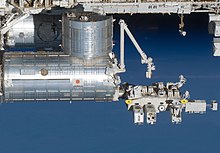Loading AI tools
From Wikipedia, the free encyclopedia
The Orbiting Carbon Observatory-3 (OCO-3) is a NASA-JPL instrument designed to measure carbon dioxide in Earth's atmosphere. The instrument is mounted on the Japanese Experiment Module-Exposed Facility on board the International Space Station (ISS).[4] OCO-3 was scheduled to be transported to space by a SpaceX Dragon from a Falcon 9 rocket on 30 April 2019,[5] but the launch was delayed to 3 May, due to problems with the space station's electrical power system.[6] This launch was further delayed to 4 May due to electrical issues aboard Of Course I Still Love You (OCISLY), the barge used to recover the Falcon 9’s first stage.[7] OCO-3 was launched as part of CRS-17 on 4 May 2019 at 06:48 UTC.[8] The nominal mission lifetime is ten years.[3]
 The Japanese Experiment Module, EFU 3 is the occupied location second from the left. | |
| Operator | NASA |
|---|---|
| Manufacturer | Jet Propulsion Laboratory[1] |
| Instrument type | Grating spectrometer |
| Function | Atmospheric CO2 and SIF |
| Mission duration | 10 years (nominal) Elapsed: 5 years, 6 months |
| Website | www |
| Properties | |
| Mass | 500 kg (1,100 lb)[2] |
| Dimensions | 1.85 × 1.0 × 0.8 m (6.1 × 3.3 × 2.6 ft) |
| Power consumption | 600 W |
| Resolution | Less than 4 km2 (1.5 sq mi) |
| Spectral band | 2.06 microns 1.61 microns 0.765 microns[3] |
| Data rate | 8 footprints, 3 Hz (24 per second) |
| Host spacecraft | |
| Spacecraft | International Space Station |
| Launch date | 4 May 2019, 06:48 UTC |
| Rocket | Falcon 9 |
| Launch site | Cape Canaveral, SLC-40 |
OCO-3 was assembled using spare materials from the Orbiting Carbon Observatory-2 satellite.[4] Because the OCO-3 instrument is similar to the OCO-2 instrument, it is expected to have similar performance with its measurements used to quantify CO2 to 1 ppm precision or better at 3 Hz.[9]
OCO-3 is constructed from spare equipment from the OCO-2 mission. Thus its physical characteristics are similar, but with some adaptations. A 2-axis pointing mirror was added, which will allow targeting of cities and other areas on order of 100 by 100 km (62 by 62 mi) for area mapping (also called "snapshot mode").[3][17][19] A 100 m (330 ft) resolution context camera was also added.[17] An onboard cryocooler will maintain detector temperatures of around −120 °C (−184 °F).[20] Entrance optics were modified to maintain a similar ground footprint to OCO-2.[3]
Similar to OCO and OCO-2, the main measurement will be of reflected near-IR sunlight. Grating spectrometers separate incoming light energy into different components of the electromagnetic spectrum (or wavelengths or "colors"). Because CO2 and molecular oxygen absorb light at specific wavelengths, the signal or absorption levels at different wavelengths provide information on the amount of gases.[20] Three bands are used called Weak CO2 (around 1.6 μm), Strong CO2 (around 2.0 μm), and Oxygen-A (around 0.76 μm).[3] There are 1,016 spectral elements per band, and measurements are made simultaneously at 8 side-by-side locations or "footprints" each about 4 km2 (1.5 sq mi) or smaller, 3 times per second.
Overall measurements from OCO-3 will help quantify sources and sinks of carbon dioxide from terrestrial ecosystems, the oceans, and from anthropogenic sources. Due to the ISS orbit, measurements will be made at latitudes less than 52°. Data from OCO-3 are expected to significantly improve understanding of global emissions from human activities, for example, using measurements over cities.[9] Near simultaneous observations from other instruments onboard the International Space Station such as ECOSTRESS (measuring plant temperatures) and Global Ecosystem Dynamics Investigation lidar (measuring forest structure) may be combined with OCO-3 observations to help improve the understanding of the terrestrial ecosystem. Similar to OCO-2, OCO-3 will also measure Solar Induced Fluorescence which is a process that occurs during plant photosynthesis.[3][21]
Seamless Wikipedia browsing. On steroids.
Every time you click a link to Wikipedia, Wiktionary or Wikiquote in your browser's search results, it will show the modern Wikiwand interface.
Wikiwand extension is a five stars, simple, with minimum permission required to keep your browsing private, safe and transparent.